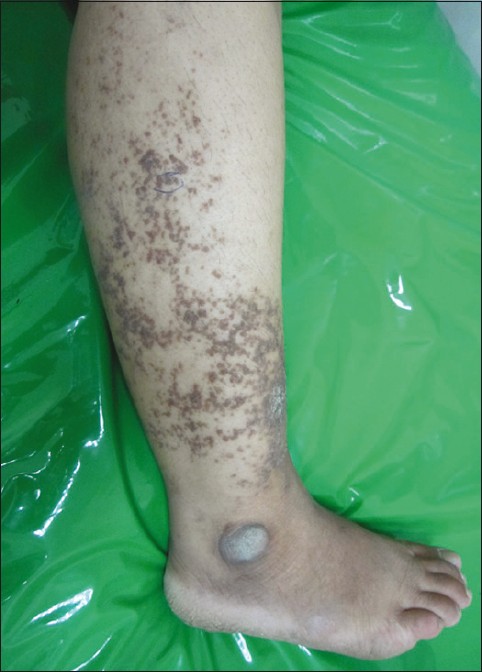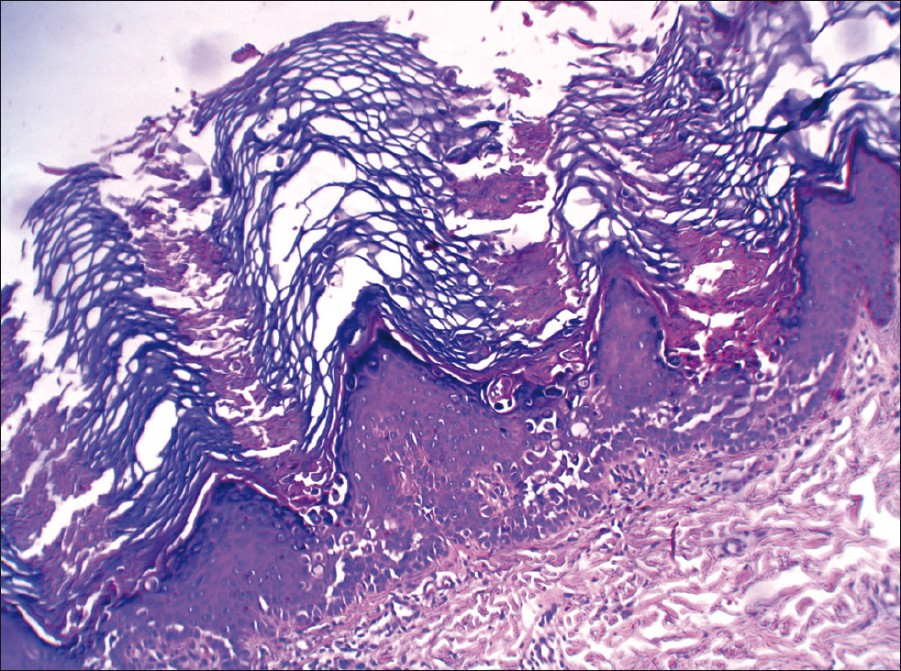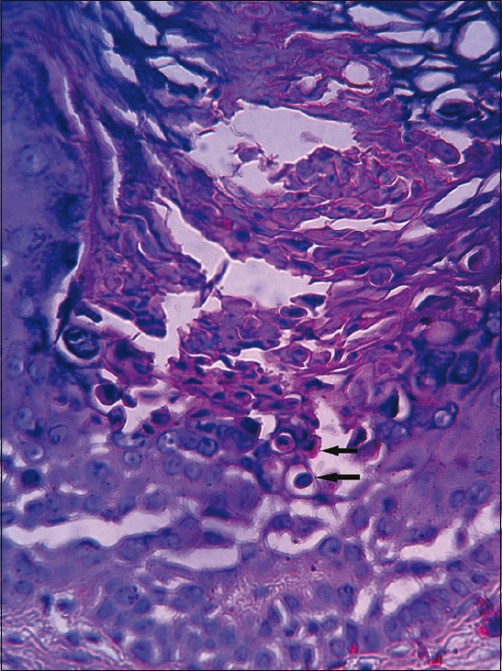Translate this page into:
Acantholytic dyskeratotic epidermal naevus
2 Department of Pathology, Ahvaz Jundishapur University of Medical Sciences, Ahvaz, Iran
Correspondence Address:
Maryam Aliabdi
Department of Dermatology, Emam Khomeini Hospital, 61335, Ahvaz
Iran
| How to cite this article: Yaghoobi R, Aliabdi M, Kheradmand P, Kazerooni A, Mehrabian A. Acantholytic dyskeratotic epidermal naevus. Indian J Dermatol Venereol Leprol 2012;78:408 |
Sir,
Acantholytic dyskeratotic epidermal naevus (ADEN) is a histological variant of epidermal naevi. Histological hallmarks include acantholytic dyskeratosis. [1],[2] Herein, we report a female patient presenting with ADEN on her lower leg.
A 38-year-old female presented with a mildly pruritic lesion on her right lower leg since 5 years ago. Physical examination revealed multiple brown-gray grouped and discrete keratotic papules over the lateral aspect of right shin in a linear distribution [Figure - 1]. She had no oral, nail or palmar sign. Family history for skin disease was negative. There was no obvious seasonal variation in patient′s symptoms. General physical condition of patient was good. The lesion did not response to emollients and high potency topical steroids.
 |
| Figure 1: Linear arrange of brown to gray keratotic papules on the right lower leg |
Histological examination of skin biopsy showed orthohyperkeratosis and acanthosis, focal suprabasal acantholysis and dyskeratotic cells resembling corps ronds in the upper layers of epidermis [Figure - 2] and [Figure - 3]. Based on these findings and also due to the absence of other features of Darier disease, negative family history and lack of seasonal variation, the diagnosis of ADEN was made for the patients lesion.
 |
| Figure 2: Hyperkeratosis, acanthosis, acantholysis and dyskeratosis (H and E, ×100) |
 |
| Figure 3: Focal acantholysis and dyskeratosis. Two dyskeratotic cells show with arrows (H and E, ×400) |
Epidermal naevi are focal area of hamartomatous proliferation of epidermis which tend to follow Blaschko′s lines in a linear, zosteriform or segmental distribution. Histological variants of epidermal naevi are described as simple epidermal hyperplasia, epidermolytic hyperkeratosis, acantholytic dyskeratosis. [1]
Darier disease is an autosomal dominant disorder due to mutation in ATP2A2 gene. About 10% of patients with Darier disease present with a segmental (linear or zosteriform) disease. It is characterized by a linear distribution of verrucous papules along Blaschko′s lines. The most common site of segmental Darier disease is trunk. [1],[2],[3]
ADEN is a linear verrucos skin condition which can closely resemble localized form of Darier disease both in clinical and histological features. [2],[4],[5]
Some authors classified ADEN as a separate entitiy, while many others suggested that ADEN is a variant of segmental (or localized) Darier disease. A review of literature revealed that in most cases, findings such as early onset age of disease, absence of other features of Darier disease, negative family history for Darier disease and lack of seasonal variation, provide clues in favor of ADEN. [1],[2],[5] However, there are reports of patients with ADEN whohave experienced worsening after sunlight, sweating and friction. [4]
Sakuntabhai et al., demonstrated that genetic mosaicism for ATP2A2 gene can cause ADEN. Based on this study ADEN could be a variant of segmental Darier disease. A case of ADEN with other features of Darier disease(nail and palmar changes)also was reported by Munro and Cox. [2],[3],[5]
Despite the early age of onset in most of ADEN cases reported in the literature, [1],[2],[5] our case developed disease at fourth decade of life. However, since she did not exhibit any feature of Darier disease and also because of negative family history and lack of seasonal variation, we report our patient as a case of ADEN rather than localized form of Darier disease.
| 1. |
Huh WK, Fujiwara K, Takahashi H, Kanitakis J. Congenital acantholytic dyskeratotic epidermal naevus following Blaschko's lines versus segmental Darier's disease. Eur J Dermatol 2007;17:130-2.
[Google Scholar]
|
| 2. |
Lee CH, Hsiao CH, Chiu HC, Tsai TF. Acantholytic dyskeratoric epidermal nevus. Indian J Dermatol Venereol Leprol 2011;77:253.
[Google Scholar]
|
| 3. |
Sakuntabhai A, Dhitavat J, Burge S, Hovnanian A. Mosaicism for ATP2A2 mutations cause segmental Darier's disease. J Invest Dermatol 2000;115:1144-7.
[Google Scholar]
|
| 4. |
Lin F, Hu S, Liang C. Seasonal recurrence of linear Darier's disease: A case report. Dermatol Sinica 2008;26:236-44.
[Google Scholar]
|
| 5. |
Ravikumar BC, Balachandra C, Ramnarayan K. Acantholytic dyskeratotic epidermal naevus on the scalp. Indian J Dermatol Venereol Leprol 2000;66:268-9.
[Google Scholar]
|
Fulltext Views
3,549
PDF downloads
2,947





